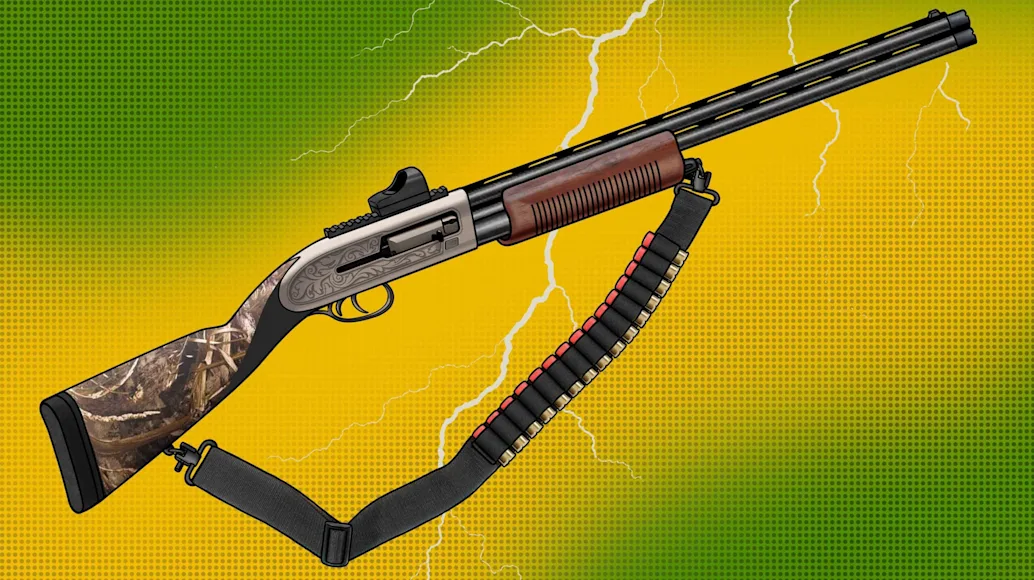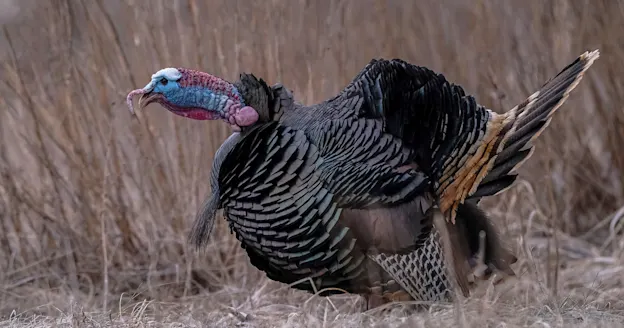We may earn revenue from the products available on this page and participate in affiliate programs. Learn more ›
Recently, one of my editors asked me if I had to use just one shotgun for all my hunting and shooting, what gun would it be? I told him that it didn’t exist, but instead would have to be stitched together out of bits and pieces of several shotguns, combining the most useful features of each.
“So,” he said, “a Frankenstein gun?”
As someone who makes a living convincing people that they need to own lots of different shotguns, I initially found the idea of a do-it-all Frankenstein gun to be, not unlike the monster itself, frightening. On the other hand, once the idea is in your head, you can’t help pondering what your very own creation might look like.
Monstrous Mash-up
I remembered that I actually saw a Frankenstein gun once, or a picture of it anyway. In the past, Field & Stream would occasionally hire artists who were totally ignorant of guns and hunting, and I was sometimes asked to review their work and recommend changes. That’s why you never saw the drawing of an over-under pump shotgun with ejection ports on both sides of the receiver. And yet, if I had to own one gun for all my hunting and shooting, an o/u pump Franken-gun makes a strange sort of sense.
An o/u pump would offer two chokes. It would have double triggers, which are the only truly instant barrel selectors. The pump action would give you a quick third shot for waterfowl, doves, and, in my case on a few unfortunate occasions, turkeys. Loading it by dropping shells in the open ports would be faster and easier than breaking open and loading a three-barreled shotgun, a few of which do exist.
My gun would have to be as slick as an old Model 12 Winchester, or a new Winchester SXP, so it could be pumped without conscious effort. I’m not sure where it would store its third shell, but that is a detail for a crack gun-design team to work out. They’ll also have to find a way to add the gas-operation feature of the 870 Competition trap model to the Franken-gun. You can look it up: For a short time in the 1980s, Remington made a single-shot 870 pump with ports in the barrel, which bled gases that impinged on a weight, resulting in a soft-recoil sensation similar to that of their gas-operated 1100. Shooting it was a surreal experience. The gun looked like an 870 and felt like an 870, but it didn’t bite like an 870. It gave you a gentle shove as it blew targets to bits.
Odd and Ends
Because it’s mine, and I do a lot of upland hunting, my Frankenstein gun will have a straight-grip stock to go with its pump fore-end. I will split the difference between pretty wood and practical plastic. It will have a synthetic fore-end so I can rest it on steel pit-blind frames without fear of dents and gouges, and a satin, oil-finished walnut buttstock. Oil doesn’t show scratches as white scars the way polyurethane does, and wood is much easier to alter and shape than plastic if I need to adjust the fit.
Since it will have 24-inch barrels—the better to use it in the turkey woods—it will come with a series of very long extended chokes of different lengths. These exist. Briley sells them for single-barrel guns, and Browning made a Citori target gun in the ’90s called the 802 ES that had both 2- and 4-inch extended tubes to change the gun’s balance and barrel length. The Franken-gun will come with 4-inch tubes to make it into a 28-inch-barrel wingshooting gun, as well as 8-inch tubes for trap and sporting clays. Also, the receiver will be cut to accommodate a micro red dot, like the cuts found on pistol slides and now on several Mossberg turkey guns.
No amount of lipstick will make this pig look good, so the receiver will have only minimal engraving, and all the metal surfaces will be Cerakoted. It will have sling-swivel studs too, and the one in the buttstock will be the kind that’s inletted and removable, eliminating the chance of a stud snagging in your vest as you mount the gun when there’s no sling attached.
As for gauge, there is only one answer: It will be a 3-inch 12, giving it the versatility to shoot loads from as light as ¾ ounce—the normal target load of a 28-gauge—up to 2-ounce turkey loads and everything in between. If you were rich enough to shoot TSS or HeviXII, you could get away with a 20-gauge model, but if you’re that rich, you can afford more than one shotgun. Besides, this gun obviously isn’t feasible, and even if it were, I destroyed the only known drawing of it in a fit of pique while it was still warm out of the fax machine.
It’s (Already) Alive!
The good news is that the real-life one-shotgun-for-everything exists, and it’s not some artist’s odd rendering. It’s a plain old gas semiauto. It’s not as cool as mine, but it’s nearly as versatile and a lot easier to get your hands on. Most gas guns made in this century have alloy receivers, which keep their weight down to around 7 pounds—neither too heavy to carry in the uplands nor too light to swing well at ducks and clays. The gas system softens the kick, compensating for the heavier recoil of a lighter gun.
Most semiautos now cycle a wide range of loads too. To my mind, 3-inch guns are more versatile than most 3½-inch 12s because the former often cycles very light loads better and you give up very little by not shooting 3½-inch shells. My old Beretta 3901 shot everything from 3-inch, 2-ounce turkey loads to my own crummy ¾-ounce reloads, and it’s far from the only semiauto with that capability.
If you would like an even lighter gun and don’t mind extra recoil, an inertia gun will weigh less than a gas gun. I had a 3½-inch Browning A5 that weighed 6¾ pounds. It was tolerable to shoot with 3-inch duck loads if I was heavily bundled up on a cold day, and it was easy to carry too.
Maybe best of all, unlike the Frankenstein gun, your real-life do-it-all shotgun doesn’t have to be monstrously ugly. Although if it is a semiauto, it will have a bolt handle sticking out of its neck.






